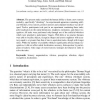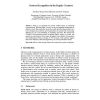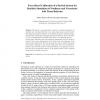HAPTICS
2010
IEEE
14 years 14 days ago
2010
IEEE
The present study examined the human ability to learn a new sensory modality, specifically "whisking". An experimental apparatus containing artificial whiskers, force sen...
HAPTICS
2010
IEEE
14 years 1 months ago
2010
IEEE
In haptic length perception biases occur that have previously been shown to depend on stimulus orientation and stimulus length. We propose that these biases arise from the muscular...
HAPTICS
2010
IEEE
14 years 1 months ago
2010
IEEE
Interactions with virtual worlds using the sense of touch, called haptic rendering, have natural applications in many domains such as health or industry. For an accurate and realis...
HAPTICS
2010
IEEE
14 years 1 months ago
2010
IEEE
Time delay in haptic telepresence arising from compression or communication alters the phase characteristics of the environment impedance. This paper describes how well a human ope...
HAPTICS
2010
IEEE
14 years 1 months ago
2010
IEEE
Touch is an important but poorly studied aspect of emotional communication. With the Haptic Creature we are investigating fundamentals of affective touch. This small robot senses t...
HAPTICS
2010
IEEE
14 years 1 months ago
2010
IEEE
We present a new approach for realistic visio-haptic simulation of nonlinear and viscoelastic behavior of an organ tissue using a particle model. The spring and damper coefficients...
HAPTICS
2010
IEEE
14 years 3 months ago
2010
IEEE
Limitations of state-of-the-art teleoperation systems can be compensated by using shared-control teleoperation architectures that provide haptic assistance to the human operator. T...
HAPTICS
2010
IEEE
14 years 4 months ago
2010
IEEE
This paper presents the MIMICS MMS rehabilitation system with a virtual rehabilitation task that includes several modes of haptic assistance. We observed the influence of these dif...
HAPTICS
2010
IEEE
14 years 4 months ago
2010
IEEE
Haptic feedback for micro- and nanomanipulation is a research area of growing importance with many potential applications in micro- and biotechnology. Past research often involves ...
HAPTICS
2010
IEEE
2010
IEEE
Influence of Visual Feedback on Passive Tactile Perception of Speed and Spacing of Rotating Gratings
14 years 4 months ago



